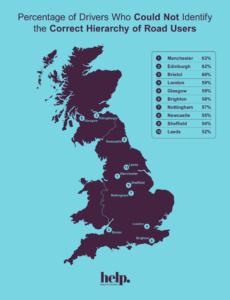Do UK Road Users Know The Highway Code?
How well do UK road users know the highway code?
We surveyed 2,000 UK drivers to test them on crucial parts of the Highway Code, to reveal just how clued-up road users are on important safety rules.
Hierarchy of road users
The hierarchy of road users places those road users who are most at risk in the event of a collision at the top:
- Pedestrians
- Cyclists
- Horse riders
- Motorcyclists
- Caravan drivers
- Bus or lorry drivers

Pedestrians are in first position, because their lack of protection makes them vulnerable in a road traffic accident. The lower a road user is in hierarchy, the more harm they and their vehicle can cause to others.
The hierarchy is intended to remind all road users to take responsibility for the safety of others and themselves.
Over half of UK drivers that we surveyed (55%) did not know the correct hierarchy of road users, with just 45% naming the correct order. Over half of cyclists (60%) also don’t know the correct hierarchy of road users, with four in ten believing they take priority over pedestrians.
Pedestrians were the most likely to correctly identify the correct hierarchy of road users (73%), followed by Motorcyclists (52%), Car/Van Drivers (46%), Cyclists (40%) and finally Bus and Lorry Drivers (17%).
There was also a significant discrepancy between the knowledge of different generations in our survey, as two thirds of those aged 65+ identified the correct hierarchy or road users, compared to just one in four 25-34 year olds.
Over one in five of those we surveyed (21%) believe that bus and lorry drivers top the hierarchy of road users, and one in six (17%) believe the highway code states cyclists, horse riders or motorcyclists are at the top of the road hierarchy.
In terms of which UK cities are the most and least clued-up with the hierarchy of road users, 63% of those surveyed in Manchester incorrectly picked the order of hierarchy. Respondents in Edinburgh (62%) and Bristol (60%) were not far behind. Bristol road users were also the most likely to have been involved in a road traffic accident (60%)
Southampton has the most clued-up residents when it comes to knowing the ‘hierarchy of road users’, with nearly two-thirds (61%) picking the correct order. Cardiff was second with 60% picking correctly, followed by Liverpool with over half (55%) knowing the hierarchy of road users.
Other misconceptions about the Highway Code
We also asked our survey respondents to identify statements that they believe are currently a part of the Highway Code.
Misconceptions about cycling
Over a third (40%) of Brits wrongly believe the term ‘cyclists have right of way over pedestrians on designated use cycle tracks’ is part of the highway code. Over a third of cyclists (35%) wrongly believe they have right of way over pedestrians on designated use cycle tracks.
Additionally, a third of pedestrians (30%) incorrectly believe cyclists hold the sole responsibility to not obstruct or cause danger in routes shared by cyclists and pedestrians.
The statement ‘’Cyclists should always wear light coloured or fluorescent clothing which helps other road users see you’ is not part of the highway code, but over a third of UK adults believe it is.
Not only this but just over a third of respondents correctly identified that cyclists are recommended to have a bell fitted to their bike (36%).
The majority of respondents also did not correctly identify that cyclists and motorcyclists should not ride on the inside of vehicles signalling or slowing down to turn left (61%).
Have you suffered a personal injury in a road traffic accident?
Nearly one third 31%) of UK adults have suffered an injury through a road traffic accident. If you need help claiming for a personal injury caused by a road traffic accident, get in touch with our personal injury solicitors today.
We’re recognised as some of the country’s leading injury accident claims and accident injury solicitors, with over 40 years’ experience helping clients and their families throughout the nation who have suffered personal injury through no fault of their own.


